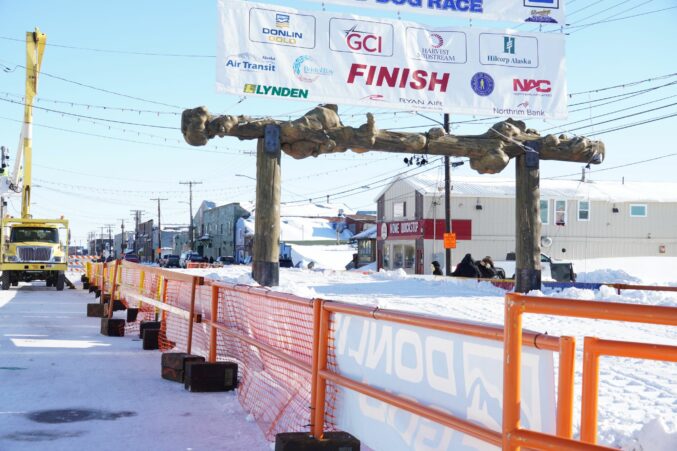I arrived in Nome today and actually got to see the finish line! I was with another new friend, a veterinarian, and we were walking through town to see what we could see. We headed down the hill—and there it was! The Finish banner! It felt surreal! The sign was up and there was the Burled Arch! My first glimpse was of the back of the arch, which I never saw in photos, and it had beautiful swirly bumps all over the back of it. National flags of participants fluttered nearby, just like at the starting line. A bulldozer was putting the finishing touches on the ramp of snow leading to the U-shaped fence. A bucket truck lifted a worker to install cameras above the arch.

The finish line, banner, and Burled Arch are getting set up on Front St. Photo: K. Newmyer
The only pictures I’d seen showed the whole area packed with people. Most of the photos were from above, so that the view was over the whole scene. But when I saw it today, it had that same real, visceral quality that so much of my experiences on the trail have been. It actually felt really different from what I had expected. There were no people around except a few tourists, and the street was quiet. I had to think about my reaction for a moment: the finish line didn’t match the picture I had in my head—not in a bad way, it just didn’t match. (The first Iditarod didn’t even have an official finish line, someone poured a packet of red Kool-Aid across the road to mark the line.)

The finish line as it looked in 1982. Photo: Iditarod Media
Imagine that’s how students feel when we coach them to finish an assignment, but they don’t have a clear picture or example of what it looks like when to be successful. I often feel that I’m doing a great job of teaching because I give good instructions and guide students to improve, especially in areas like writing. But I don’t think I’m always successful at giving students the clear picture of the finish line. It’s not that I’m not doing a good job of teaching my content, it’s that I’m not really making sure that the students know exactly what their finished product should look like.
The instructional coaches at my campus do a great job of helping teachers create success criteria. For each assessment or major assignment, we work together in teams to lay out exactly what it will look like when students can show what we are asking them to learn. For example, if I’m teaching my reading students to analyze informational texts by describing various author’s choices, such as how the text is organized and what the author’s purpose is, I want to post in my room an example with a different text. It’s one thing for students to volunteer to identify these things in a discussion, it’s another thing when the real final product is a cogently written paragraph describing the author’s methods.
As you plan, consider including success criteria in your lessons. This is a great activity to do with your teaching team or instructional coaches. Pretend you are a student and map out what their finished product looks like. What kinds of information do you need to include? What does a neatly worked math problem look like? Provide examples of completed lab reports, maps, or paragraphs with good topic sentences. If you are having students create posters, infographics or other creative products, provide examples from previous years, or create one yourself that students can look at to see what a good one looks like.
If I were a musher in the Iditarod, I would want to see examples of what good mushers do when they enter a checkpoint and begin their dog care routine. I’d like to see examples of how they set up their sleds so they can find everything they need quickly and easily. I want someone to explain to me what I’m looking for when I examine a dog’s gait (how it runs), the information you can learn from a dog’s tail, and many other tricks of the trade. As a teacher, you can present your success criteria to students and have a discussion about what makes it good, what are the details they notice, and set a goal for themselves to work on things they struggle with.

Back of the Burled Arch. Photo: K. Newmyer
When I saw the Burled Arch, I could really see, for the first time, what the mushers are striving for all those long, cold miles on the trail. My flight today took us past White Mountain, a gleaming ridge of snowy white, and into Nome. I imagined that the mushers were counting down the miles and minutes before they reached front street, mushing down the edge of the Bering Sea Ice. I can imagine that they picture the Burled Arch in their minds, with the iconic sign over the top that says FINISH. The city of Nome has a comfortable, weathered feel, and the Burled Arch represents a distance traveled that is far in spirit from the partying crowds on 4th Street in Anchorage.
A huge benefit of using success criteria is the ability to shift the work of assessment from the teacher to the student. The student will have a clear picture of what they need to do in order to show their learning—not the mismatched picture of the finish line that I had in my mind. This helps students be able to judge their own success, comparing their work to the example. Then they will be able to cross their own successful finish line, just like this year’s Iditarod mushers will begin to do tomorrow. You can even create a Burled Arch for your students to display finished work, with an Iditarod sign above it. Do a “mandatory gear check” to celebrate the finish line—and they can sign the checker’s clipboard and place their work under the Burled Arch.

2020 Iditarod Champion Thomas Waerner waves the Norwegian flag after crossing the finish line in Nome. Photo: Iditarod Media
How do you celebrate student success, Iditarod style? Email me at emailtheteacher@iditarod.com.


